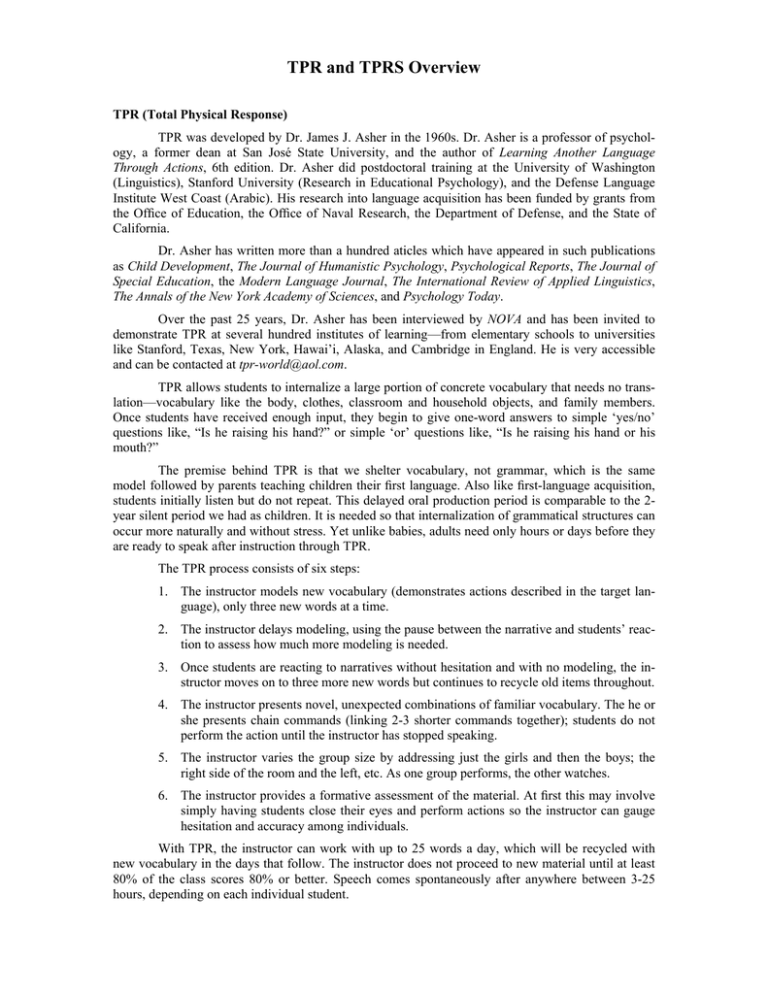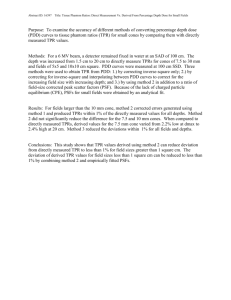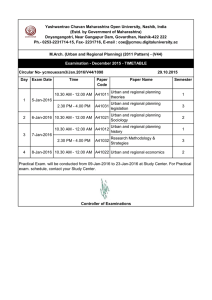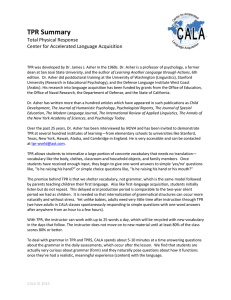TPR and TPRS Overview
advertisement

TPR and TPRS Overview TPR (Total Physical Response) TPR was developed by Dr. James J. Asher in the 1960s. Dr. Asher is a professor of psychology, a former dean at San José State University, and the author of Learning Another Language Through Actions, 6th edition. Dr. Asher did postdoctoral training at the University of Washington (Linguistics), Stanford University (Research in Educational Psychology), and the Defense Language Institute West Coast (Arabic). His research into language acquisition has been funded by grants from the Office of Education, the Office of Naval Research, the Department of Defense, and the State of California. Dr. Asher has written more than a hundred aticles which have appeared in such publications as Child Development, The Journal of Humanistic Psychology, Psychological Reports, The Journal of Special Education, the Modern Language Journal, The International Review of Applied Linguistics, The Annals of the New York Academy of Sciences, and Psychology Today. Over the past 25 years, Dr. Asher has been interviewed by NOVA and has been invited to demonstrate TPR at several hundred institutes of learning—from elementary schools to universities like Stanford, Texas, New York, Hawai’i, Alaska, and Cambridge in England. He is very accessible and can be contacted at tpr-world@aol.com. TPR allows students to internalize a large portion of concrete vocabulary that needs no translation—vocabulary like the body, clothes, classroom and household objects, and family members. Once students have received enough input, they begin to give one-word answers to simple ‘yes/no’ questions like, “Is he raising his hand?” or simple ‘or’ questions like, “Is he raising his hand or his mouth?” The premise behind TPR is that we shelter vocabulary, not grammar, which is the same model followed by parents teaching children their first language. Also like first-language acquisition, students initially listen but do not repeat. This delayed oral production period is comparable to the 2year silent period we had as children. It is needed so that internalization of grammatical structures can occur more naturally and without stress. Yet unlike babies, adults need only hours or days before they are ready to speak after instruction through TPR. The TPR process consists of six steps: 1. The instructor models new vocabulary (demonstrates actions described in the target language), only three new words at a time. 2. The instructor delays modeling, using the pause between the narrative and students’ reaction to assess how much more modeling is needed. 3. Once students are reacting to narratives without hesitation and with no modeling, the instructor moves on to three more new words but continues to recycle old items throughout. 4. The instructor presents novel, unexpected combinations of familiar vocabulary. The he or she presents chain commands (linking 2-3 shorter commands together); students do not perform the action until the instructor has stopped speaking. 5. The instructor varies the group size by addressing just the girls and then the boys; the right side of the room and the left, etc. As one group performs, the other watches. 6. The instructor provides a formative assessment of the material. At first this may involve simply having students close their eyes and perform actions so the instructor can gauge hesitation and accuracy among individuals. With TPR, the instructor can work with up to 25 words a day, which will be recycled with new vocabulary in the days that follow. The instructor does not proceed to new material until at least 80% of the class scores 80% or better. Speech comes spontaneously after anywhere between 3-25 hours, depending on each individual student. TPRS (Teaching Proficiency through Reading and Storytelling) TPRS is used to teach abstract vocabulary that cannot be covered through TPR alone. The TPRS method was developed as an outgrowth of TPR by a high school Spanish teacher named Blaine Ray in the 1990s. This method begins with a small story created by the teacher, and the story is constructed around the repetition of three new abstract phrases. A more descriptive name for the process would be ‘storyasking’, since the teacher is constantly asking the story into existence. It shifts students from answering the lower-level questions of TPR (yes’no, choices, W-words) to answering questions that require higher-level thinking skills involving fantasy creation and personalization of the original story. The teacher has a structure of questioning that must be followed, yet at the same time, he or she must be able to take this line of questioning into whatever direction the students take the story. TPRS should be preceded by TPR until students have a vocabulary base of about 100-150 words, which takes about 1-2 weeks of foreign language classes at the high school level and 2-4 weeks of college (since there are fewer college sessions per week). The following steps require a good 90 minutes; shorter classes can take up where they left off the preceding day. 1. Choose a gesture to represent each of the 3 expressions. Gesture for one minute until students can do gestures with eyes closed when the teacher gives the expressions. 2. Teacher tells and asks questions about the story while 1-3 students act out the story; others help create the story with the teacher. 3. The teacher retells the story with mistakes that students correct. 4. As students read through the story that was just acted out, the instructor points out a few points of grammar, focusing initially on meaning; this is known as pop-up grammar questioning. For example, we say ‘What is the verb ending for they and he?’ not ‘What are the third person plural and singular verb endings?’ Answer any other questions from the students. 5. The instructor hands out an extended reading that uses the new structures and that is much longer than the original story. He or she poses comprehension questions in the target language. 6. Students complete a timed writing of the original story, given 5 minutes to write as much of either story they can recall in the target language. 7. Using a list of guide words (verbs), students retell the original story in pairs, and then a volunteer retells the story to the class. The instructor should do no more than three expressions per day. Words must be repeated in varied contexts at least 50-100 times before students are able to internalize them. By starting with approximately a dozen words in three expressions, students are ultimately able to read an extended story of 300 words because of the surrounding contextual clues. Dealing with Grammar To deal with grammar in TPR and TPRS, we spend about 5-10 minutes at a time analyzing the grammar in the daily assessments, which occur after the lesson. We find students are actually very curious about grammar (form) and how it functions once they’ve had a realistic, meaningful experience (content) with the language.


